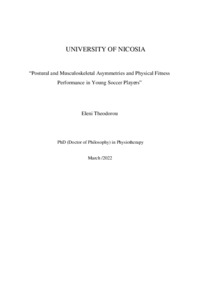- Theodorou, Eleni
- School of Sciences and Engineering
- Department of Life and Health Sciences
- June 2022
- English
- 251 pages
- Hadjicharalambous, Marios | Tryfonidis, Marios | Leptos, Petros
- Postural asymmetries | Assessment | Youth soccer | Individual corrective exercise program | Performance
- Social science -- Life and health sciences
-
-
Introduction: Several studies have pointed out the relationship between postural asymmetries and injuries in young soccer players. The aims of the present thesis were a) to examine whether there was a correlation between the side of spinal rotation and leg dominance (EXP 1) in young soccer players, b) to test whether there were significant postural asymmetries after 8-weeks individual exercise intervention (EXP 2) and c) to examine whether there was an association between spinal asymmetries and certain physical fitness performance in young elite soccer players (EXP 3). Methodology: The assessment in EXP 1 (n=610) and EXP 2 (n=94) consisted of a battery of tests and measurements for postural and musculoskeletal asymmetries. In EXP 3 (n=50), physical fitness performance evaluation tests were also performed; sit and reach, CMJ and isokinetic, and players were categorized in normal (NG) and asymmetry (AG) groups according to the spinal asymmetries assessment Results: In EXP 1, the dominant leg was found to be negatively correlated with the side of spinal rotation (r=-0.131, p < 0.001) and among functional scoliotic players (n=66) (r=-0.447, p < 0.001). In EXP 2, there was a significant improvement of the primary angle of trunk rotation (r=-056, p < 0.001), the hamstring flexibility right (r=-0.55, p < 0.001) and left (r=-48, p < 0.001), the hip external rotation right (r=-0.46, p < 0.001) and left (r=-0.26, p=0.020), the hip internal rotation right (r=-0.26, p=0.021) and left (r=-0.35, p=0.002), Stork Test (opened eyes) right (r=-0.33, p=0.003) and left (r=-0.33, p=0.003), Stork Test (closed eyes) right (r=-0.39, p<0.001) and left (r=-0.43, p<0.001), Thomas test right (χ2(3) = 52.281, p = 0.001, γ ̂= -0.751) and left (χ2(3) = 45.832, p = 0.001, γ ̂ = - 0.696), and ankle dorsiflexion (flexed knees) (χ2(2) = 13.019, p = 0.005, V = 0.285). In EXP 3, spinal asymmetries were found to affect physical fitness performance; Sit-and-reach flexibility was lower (p=0.024) and higher (p=0.04) in the scoliotic and lordotic posture asymmetry group (AG), respectively compared with the normal group (NG). Countermovement jump (CMJ) with arm swing was lower in kyphotic AG (p=0.028) than the NG. In scoliotic posture, CMJ for the right (p=0.008) and the left (p=0.002) legs were in AG than the NG Conclusions: Leg dominance in youth soccer players can cause spinal rotation on the contralateral side. Additional causes such as leg length discrepancy and pelvic tilt can result in functional scoliosis. An 8-weeks interventional individual corrective exercise program can improve postural asymmetries in young male soccer players between 12 to 17 years old. Kyphotic and scoliotic posture asymmetries might negatively affect neuromuscular status and explosive performance and diminish lower limbs’ flexibility in young elite soccer players. Young soccer players should be regularly screened for postural and musculoskeletal asymmetries for improving their long-term athletic development.
-
Postural and Musculoskeletal Asymmetries and Physical Fitness Performance in Young Soccer Players
| Type | Location | Link |
|---|---|---|
| dissertation | [More information] |

